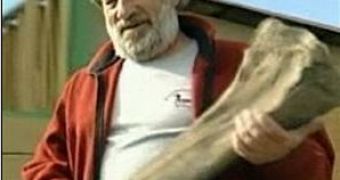Thousands of years following their extinction, mammoths still help people earn a living. In the Siberian tundra, the frozen grassland high up in the Arctic Circle, the climbing temperature is thawing out the permafrost (the frozen soil) to show off the fossilized bones of prehistoric megafauna like mammoths, woolly rhinos and cave lions. Private collectors and institutes will pay generously for the best specimens.
"Last year someone was paid 800,000 roubles ($31,000) for a mammoth head with two tusks in great condition," said Russian bone-prospectors and hunter Alexander Vatagin, 45, operating in northeastern Siberia, eight time zones from Moscow.
Vatagin's operations are based on the Yukagirs, a Siberian tribe of fishermen and reindeer-herders of just around 800 people. "I must have earned the respect of the Yukagir. Their shamans convened a council and decided to name me a Yukagir," said Vatagin, who is now Yukagir No. 456.
The tribesmen herding their reindeer are roaming across the vast emptiness of the tundra, encountering the valuable artifacts. At regular intervals, Vatagin goes by helicopter to the main Yukagir settlement, Andryushkino, located 200 km (125 mi) west of the center of the region, Chersky, to inspect the merchandise.
The fossils are not hard to discover, as in some places, the bones pop up to the surface at every few meters due to the rapid thawing and break up of the permafrost. More skill and knowledge is required to detect really valuable material.
Vatagin pays the Yukagirs between 200 ($8) and 4,000 roubles ($156) per kg of mammoth bones, but curled tusks, sometimes up to 5 m (15 ft) in length, are the most priced pieces. It is rare to find a pair of them in good condition, and such a pair attached to a well-preserved skull can cost a fortune. "If he is lucky, a local can earn 200,000 roubles ($7,800) in just one day. To earn this money, he would have otherwise have to toil for a year.", said Vatagin.
For Vatagin, this is also a hobby (not only a business): he himself dives into the ice-cold rivers to search for relics. Many of the encountered bones are headed towards the Ice Age Museum in Moscow, which combines scientific discovery with economy. The National Alliance, a company run by entrepreneur Fyodor Shidlovsky, runs the museum, and has government licenses for digging and exporting prehistoric relics.
"A well-preserved tusk can sell to private collectors for up to $20,000, while a reconstructed mammoth skeleton can fetch between $150,000 and $250,000." said Alexander Svalov, chief executive of National Alliance and museum's official. Many bones are sold to museums from US, South Korea or China. "Developing nations are now displaying huge interest in mammoths. Their economies are growing, they have cash and are starting to develop their museums.", said Svalov.
Still, others see this differently. Sergei Davydov, 52, a researcher resident to Chersky, does not sell the encountered bones, which he keeps to investigate the effects of climate change, but also because he's fascinated by them.
"This tooth has an unusual bump here. The mammoth suffered from a terrible toothache. We can only imagine how he must have roared," said Davydov, showing a black tooth as big as a large shoe. His collection also include mammoth's giant femurs, woolly rhino horns, ancient horse jaws, horned skulls of prehistoric bison and a cave lion's skull. "As the permafrost thaws, we obtain yet more objects for study. From the point of view of humanity, it would have been better if this had never happened", Davydov said.

 14 DAY TRIAL //
14 DAY TRIAL //